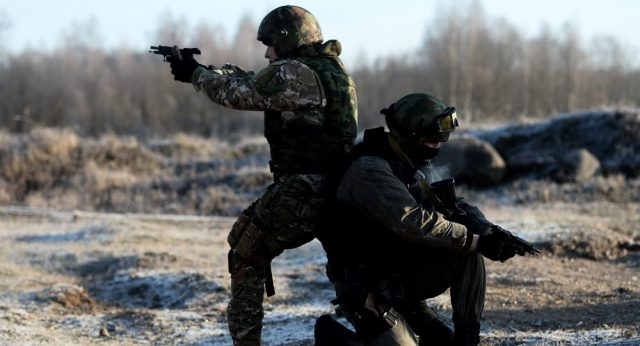
Random Deaths Increasingly Frequent, as Innocent Civilians Mistaken for Rebels in Dagestan
Publication: Eurasia Daily Monitor Volume: 13 Issue: 144
By:

At 10:30 PM, on August 5, in the Dagestani village of Karamakhi, police on patrol came under attack by unidentified individuals armed with grenade launchers. Three police officers and a local resident received injuries in the incident. “Unknown individuals fired shots at the police officers, who were checking motor vehicles. The attackers used automatic weapons and grenade launchers,” officials said. Besides the injuries to the three police officers and a civilian, several trucks were damaged in the incident (Kavkazsky Uzel, August 6).
On the evening of August 10, unidentified individuals shot and killed Uibadulla Magomedov at his home in the village of Assab (Dagestan’s Shamilsky district). The assailants used automatic weapons. The victim had not informed the authorities of any threats on his life prior to his death. Investigators are primarily considering victim’s professional activities as the killers’ motive. Magomedov, 60, was employed as the judge of Shamilsky district court since 2004 (Meduza.io, August 11).
The following day, government forces killed a rebel in the Dagestani village of Andi. At 5:30 AM, the authorities had introduced a counter-terrorist operation regime (Echo.msk.ru, August 11). Several homes where suspected insurgents may have been hiding were sealed off, but only one suspect was eventually killed. Notably, government forces had tried to arrest people in this village previously. Only in 2016, a counter-terrorist operation regime was introduced in the village several times, but during previous occasions, no one was caught.
In the city of Izberbash, on August 12, unidentified individuals fired shots at a police patrol, killing two law enforcement officers (Gazeta.ru, August 12).
In Dagestan’s Magaramkent district, government forces caught in a shootout killed a rebel who was on the Russian federal wanted list. On the night of August 13, the federal security forces asked a man in the village of Tagirkent-Kazmalyar to show his documents. In response, the man fired shots and was killed by the police. The authorities informed later that the killed man was Alikber Aliskerov, who was wanted for several terrorism-related crimes (Gazeta.ru, August 14).
In Shamil district of Dagestan, two rebels were killed after firing shots at the police. The deadly exchange took place on August 23, around 9:45 PM, in one of the republic’s mountain gorges. According to the police, the armed men fired their weapons after being asked by the police to show their IDs. Both suspects were killed in the shootout that followed. The police later claimed that the killed individuals were members of the so-called “Shamil” group of the armed Islamist underground movement (Kavkavsky Uzel, August 24). According to the police, they confiscated Kalashnikovs from both killed suspects (Interfax, August 23).
However, it later transpired that the killed individuals apparently had nothing to do with the rebels. According to locals, the police had actually killed two shepherds, but for some reason left weapons in their hands, as if to emphasize that they were insurgents. The two dead men, identified as brothers Gasangusein (20) and Nabi Gasanguseinov (17), had left home that day wearing light clothing typical for this time of year in Dagestan, but they were ultimately found dressed in warm khaki-colored jackets. The body of one of the shepherds was riddled with 11 bullets, while the other had 6. Moreover, the holes on their bodies and their vests did not coincide. No one in the three villages nearby heard sounds of shooting, which means that the security forces must have killed the two brothers using silencers. It appears that when the security services realized they killed the wrong men, they dressed the dead bodies in military jackets and left Kalashnikovs in their hands. The incident became widely known, due to the intervention of the well-known Russian journalist Maksim Shevchenko (Kavkazsky Uzel, August 24; Echo.msk.ru, September 1).
The official announcement that designated the shepherds as rebels angered the villagers in the three villages of Shamilsky district. They demanded an apology from the government and for the authorities to investigate the killing of the two innocent men. On August 26, residents of the village Goor-Khindakh issued an open letter in connection with the killing of the Gasanguseinov brothers. The villagers could retrieve the bodies of the brothers only after staging a protest in front of the police station. Dagestani investigators quickly realized that the two men were not rebels and thus handed over the two brothers’ bodies to their relatives for burial. The bodies of rebels are usually not returned to their relatives, according to Russian laws (Kavkazsky Uzel, August 24; Echo.msk.ru, September 1).
The story of the killing of the Gasanguseinov brothers illustrates how the Russian security services manipulate facts and stage random victims to look like rebels after their deaths. News reports of police killing individuals after trying to check their documents are often hidden examples of such manipulation. Indeed, in nearly all such instances, the suspects somehow never seem able to kill law enforcement officials while shooting at them in close quarters at a police checkpoint. As such, the situation in Dagestan remains tense and disconcerting. And the evident absence of coordination between the civilian authorities and the government’s Armed Forces regularly results in tragedies.




